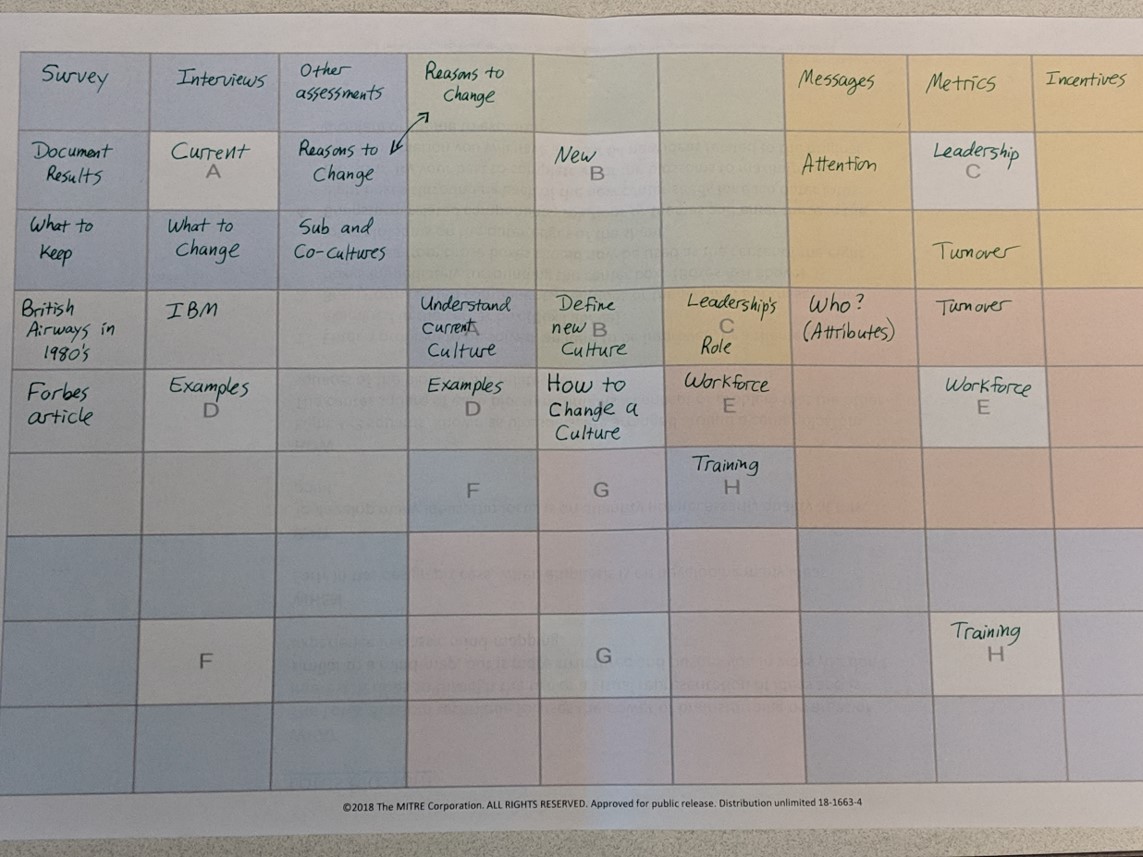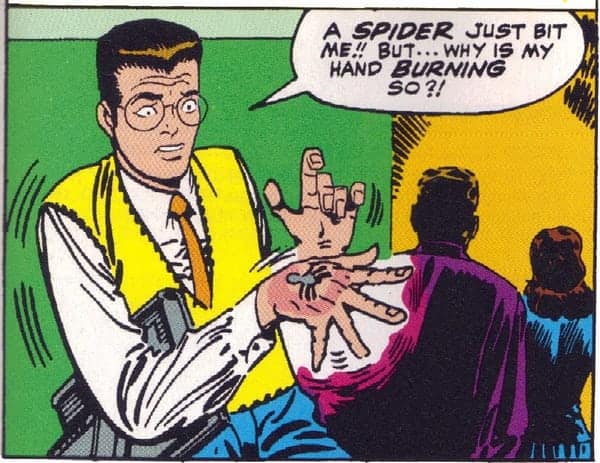
by dbward | Apr 29, 2019 | Tools 101
This week’s post is about an ideation tool called the Lotus Blossom.
This colorful & simple tool is like Mindmapping on a grid. It helps people go deeper / get more creative than a standard brainstorming session. Also, engineers tend to LOVE this one.
The photo below shows an example of a partially filled-out Lotus Blossom. To get started write the topic, problem, or concept you’re working on in the center box. In the example I wrote Culture Change. In the 8 colorful boxes around it (A-H) write down facets of the problem / topic / etc. In my example, I wrote understand the current culture, define the new culture, leadership’s role, and so on.
Next, expand the blossom from the central box to the outer boxes (aka the blossoms). To do this, just copy the words from the middle grid to the lettered boxes on the outside of the grid. You’ll see the word Current in the white box in the upper left corner.
Then add the next level of detail in the colored boxes around each blossom. So Current Culture might involve doing a survey, performing interviews, and documenting our research results.
Keep going until you’ve filled in all the boxes.
Full instructions and a downloadable template are available here.
by rgregorio | Apr 22, 2019 | Team Toolkit

Photo by Hunter Haley on Unsplash
When you hear the word “toolkit,” the automatic image that enters your mind is probably a metal box tucked away in a garage filled with home improvement tools.
However, toolkits have been around for almost 3.3 million years. We use them in our lives all the time even though we might not know it. Where did toolkits come from? The first Toolkit originated from Lomekwi 3 in West Turkana, Kenya. It was made up of basic tools like stone hammers and stones that were sharpened to cut or smash wood and food.
All toolkits are different but they all are similar in one way. They help make our lives easier and do things more efficiently and simpler.
Not all toolkits are made up of drills, hammers and screw drivers. Some are made up of methods or processes like the MITRE Innovation Toolkit (ITK). More modern toolkits are used for innovation and creative problem-solving. This new concept helps the user figure out solutions in a more effective way. They also have the ability to adapt the tools for their own purpose and perspective. Like ITK, we have tools that make the users look at possibilities, causes, and solutions to their problem by laying out their thoughts out on paper for a more collaborative effect.
Even after 3.3 million years, we still go back to that same concept of using and creating toolkits to help make our lives easier and be more efficient. What would you put in your toolkit?

by Stephanie Medicke | Apr 15, 2019 | Uncategorized
All companies and teams include multiple disciplines and members with different expertise, so why shouldn’t our meetings and brainstorming sessions?
Multidisciplinary collaboration means building a team of members with different backgrounds and skills that can compensate each other and work together toward the same direction to achieve the same goals. Multidisciplinary teams usually generate a wide range of ideas that are more diverse than a homogenous team can.
Also consider an interdisciplinary approach. Interdisciplinary teams are made up of people with a deep understanding of a particular skillset complimented by beginner or intermediate mastery of a diversity of other disciplines. These teams are not only able to generate many different exclusive ideas, but are able to see connections between seemingly disparate ideas. This mindset and dynamic is critical in the double diamond approach when converging on ideas.
by Aileen Laughlin | Apr 8, 2019 | Team Toolkit
 In today’s episode, we’re telling the Team Toolkit’s Origin Story! No, we weren’t all bitten by radioactive spiders or exposed to gamma rays, although a couple of us are still hoping that will happen eventually.
In today’s episode, we’re telling the Team Toolkit’s Origin Story! No, we weren’t all bitten by radioactive spiders or exposed to gamma rays, although a couple of us are still hoping that will happen eventually.
Team Toolkit actually came together through an innovation interest group stood up by Dan Ward. Our first project was consulting for a start-up interested in tailoring their product for the military. Little did we know where this journey would take us!
While working with the start-up, we found a lot of overlap in the problems and challenges we encounter with our other work. We began to ask how we might help others think and work more like innovators. How might we shift the mindset from solutions to understanding problems, helping to get a job done, and delivering value? We looked across industry and discovered the concept of an innovation toolkit, a collection of methods, tools, and techniques to help individuals kick-start innovation.
One of the more important things we learned during our research is that toolkits 1) require tailoring for your problems and culture and 2) can’t just be tossed over the fence with a “good luck.”
We set out to tailor our toolkit by surveying dozens of toolkits from industry, academia, and government. We took our knowledge of MITRE and our Sponsor’s problems and paired it with our experiences successfully applying these tools across projects and ended up with the initial 24 tools found on our website. (Yes, we used the toolkit to develop the toolkit!)
We began experimenting by offering it up to projects and programs, found some early adopters and champions and it really took off from there. But that’s not the end of the story! We’re constantly gathering feedback from users so that we can further iterate on the toolkit. Our goal is to build a widespread community of practitioners and innovators to keep the toolkit contents fresh and provide a platform for sharing best practices, tips, and success stories. Join us and share your story!
by dbward | Apr 1, 2019 | Uncategorized |
We’ve got a guest blogger this week – ITK superfan and creative partner Liz Borseti, who shares her story of working with Team Toolkit.
As a member of MITRE’s strategic communications team, I thought I knew the most creative people who work at the company. From writers to designers to photographers, my colleagues are brimming with imagination. So when I was asked to work on a communications plan for the new Innovation Toolkit, I figured it was an ordinary assignment. We would bring an artistic perspective to the table, using a part of the brain most of our engineering colleagues don’t usually tap into.
But from the first meeting with Team Toolkit, I was surprised and happy to learn that I was wrong – creativity and imagination exist in abundance across the organization. And ITK turned out to be one of the most creatively intelligent and collaborative projects I have ever had the pleasure to work on.
As we worked diligently to evolve items like the ITK website and logo, there was a constant back and forth between the teams, learning from each other and building upon each other’s design ideas. Where strategic communications brought expert knowledge of writing, editing, and design, ITK complemented with user-centric concepts, toolkit expertise, and even a cartoon series.
Team Toolkit even encouraged our communications team to use the Premortem tool as we designed a pamphlet for the Premortem tool (Toolception!).
Team Toolkit has the skills to extract the maximum potential of any team or individual. Along with their toolkit, they bring a positive, forward-thinking attitude to every project. I was lucky to experience this first hand as we completed some great work together, using the power of collaboration and systemic creative thinking.
For anyone looking to deliver mission impact on their project, ITK is the place to start. Team Toolkit are not just curators for ITK, but they truly believe in the power of innovative thinking to deliver success for MITRE, our sponsors, and our mission.
Liz Borseti
ITK collaborator, user, and superfan




